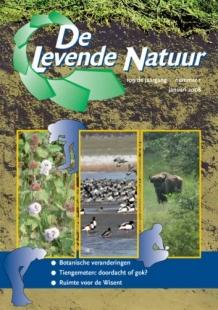De Levende Natuur nummer 1 van 2008 (English summary)
Afbeelding

Botanical changes in Dutch natural areas 1999-2005
Duuren, L. van, T. van der Meij, M. Rijken, M.P. van Veen & A.J. van Strien
A national monitoring scheme of the Dutch flora has been started in 1999. This monitoring programme surveys the changes in the flora by means of permanent plots. The aim of the monitoring is to determine the effects of environmental changes. The last seven years an increase of shrubs in many nature areas in the Netherlands occurs. This phenomenon can be seen in all kinds of biotopes with exception of heath land. This development seems to be caused by a succession of vegetation rather then the effect of nitrogen deposition. Another remarkable phenomenon is also the beginning of recovery of wet dune valleys.
Hand-cockle fisheries in the Dutch Wadden Sea may well be in conflict with nature conservation principles
Leeuwe, M.A., E.O. Folmer, A. Dekinga, C. Kraan, K. Meijer & T. Piersma
In the Dutch Wadden Sea, granting permits regulates hand-cockle fishery activity. With <20 permits in the ‘90’s hand-cockle fishery was considered a sustainable activity. With increasing activity since the ban of mechanical dredging for cockles in 2005, a conflict with the principles of nature conservation could well have arisen. Both fishermen and birds focus their needs on locations where large sized cockles occur in high densities. During two intensive surveys (> 2500 sampling points on a dispersed 250 m grid) in August-September 2004 and 2006, it was found that densities of > 600 cockles/m2 were restricted to 0.5-2.5% of the total surface area of intertidal flats in the Wadden Sea. In years of low cockle abundance (e.g. 2004), hand-cockle fishery remove the larger part of the food for shorebirds, as well as the part that is responsible for most of the bivalve recruitment. Moreover, the survey showed that especially the richer areas are characterised by a high biodiversity and high biomass of non-target species. With the extension of fishery activities, the disturbance of sediment may have negative consequences for sediment structure and associated macrozoobenthic intertidal fauna. It is recommended that the permit system is properly re-evaluated.
Wistfulness, Wealth and Wilderness;
Boo-Spaargaren, M.Y. de
The island of Tiengemeten has been given back to nature. Six farmers have been re-allocated to the mainland and 700 hectares of agricultural land have been turned into a nature reserve. Tiengemeten has been designated as an area for tidal flora and fauna, with plenty opportunities for recreation. Picturesque old farmhouses and other buildings have been restored in order to keep the memories of the old days alive. Most of the island will change in a true ‘Wilderness’. New creeks have been dug and in the large surrounding outer dyke an opening has been created in order to let the tidal water in. Scottish Highland cattle and horses are roaming the wilderness, thus creating a more diverse vegetation. The middle part of the island, named ‘Wealth’, will turn into one large, open stretch of water in winter. Thousands of geese, wigeons and other types of duck will be resting here. In the eastern part, named ‘Wistfulness’, the atmosphere of the 1850’s countryside will revive. Old fashioned wheat growing practices will create a valuable biotope for native arable herbs and forgotten farmland flowers and for rare farmland and meadow birds. The island of Tiengemeten is part of the European Natura 2000 Network. It hosts some of Europe's most threatened species and habitats.
The island of Tiengemeten has been inundated. Though well-considered, the project could be an environmental gamble
Ouweneel, G.L.
Spring 2007 the island of Tiengemeten was officially transferred to the Vereniging Natuurmonumenten, the biggest private nature conservation organization in The Netherlands. Tiengemeten is situated in the Haringvliet, the most northern estuary in the Dutch Delta. Tiengemeten measures about 1000 acres, 700 acres polder and 300 acres outside the dikes. In 1994 Dutch authorities decided to give the destination ‘nature’ to Tiengemeten. At the same time the organization ‘Deltanatuur’ was established. In ‘Deltanatuur’ several governmental and private corporations are represented. The task of ‘Deltanatuur’ is to create 3000 acres of new wetlands along the estuaries of the northern Delta. Tiengemeten forms a part of the ‘Deltanatuur’ projects. Natuurmonumenten planned to divide the island in three clusters, indicated with ‘Wilderness’, ‘Wealth’ and ‘Wishfulness’. The first two with a total surface of 900 acres have a direct connection with the Haringvliet estuary. It is expected and already proven that big flocks of geese, ducks and waders will be attracted by the tidal mudflats in these two parts. In spring, the soil is gradually drying out and tens of thousands of waders are foraging on the mud flats. In the shallow waters Spoonbills and Egrets can be observed. Grey geese visit open, safe marsh, rich in food, when moulting in May and June. In summer, Meadow pipit and Redshank are breeding in the meadows. In ‘Wishfulness’ Natuurmonumenten intends to create an old Zealand farmlandscape. Besides birds, it is expected that rushes can return. Before the closure of the Haringvliet large fields of rushes occurred. After the closure these rushes disappeared completely. However, the success of Tiengemeten and other ‘Deltanatuur’ projects depends considerably on a soon realization of the ‘Kierbesluit’. In 2001 Dutch authorities decided during normal circumstances to open the Haringvlietsluices constantly a crack. Migrating fish species as Twaite, Salmon, Shad, Sea-lamprey and even Sturgeon will get the possibility again to reach spawning-grounds situated in the Upper-Rhine. The original plan should start with the ‘Kierbesluit’ in 2005; it will be realised not before 2010.


